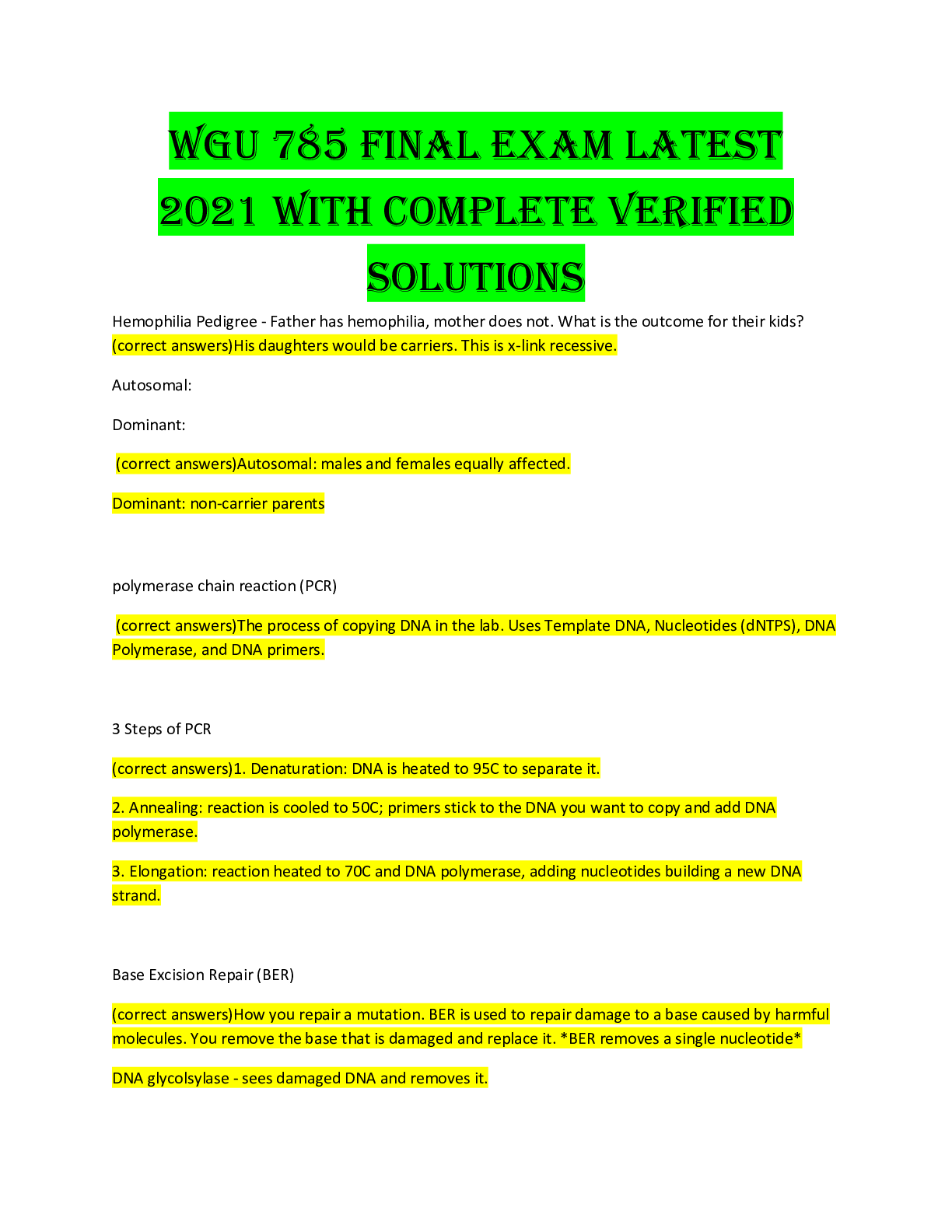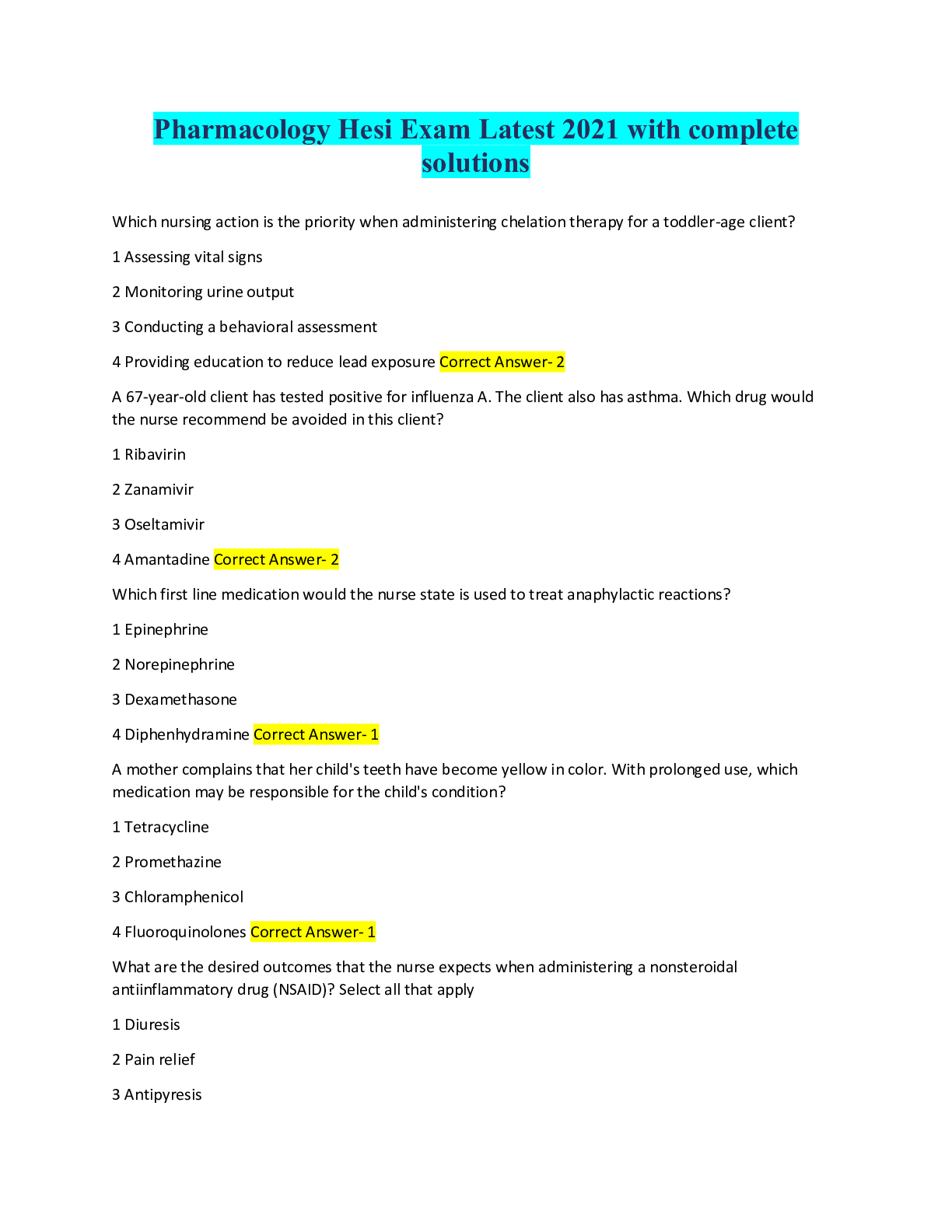BioChemistry > QUESTIONS & ANSWERS > WGU 785 Final Exam Latest 2021 With Complete Solution Already Passed (All)
WGU 785 Final Exam Latest 2021 With Complete Solution Already Passed
Document Content and Description Below
WGU 785 Final Exam Latest 2021 with Complete Solution Hemophilia Pedigree - Father has hemophilia, mother does not. What is the outcome for their kids? - ANS His daughters would be carriers. This is ... x-link recessive. Autosomal: Dominant: - ANS Autosomal: males and females equally affected. Dominant: non-carrier parents Polymerase chain reaction (PCR) ANS The process of copying DNA in the lab. Uses Template DNA, Nucleotides (dNTPS), DNA polymerase, and DNA primers. 3 Steps of PCR ANS 1. Denaturation: DNA is heated to 95C to separate it. 2. Annealing: reaction is cooled to 50C; primers stick to the DNA you want to copy and add DNA polymerase. 3. Elongation: reaction heated to 70C and DNA polymerase, adding nucleotides building a new DNA strand. Base Excision Repair (BER) ANS How you repair a mutation. BER is used to repair damage to a base caused by harmful molecules. You remove the base that is damaged and replace it. *BER removes a single nucleotide* DNA glycolsylase - sees damaged DNA and removes it. DNA polymerase-puts the right one back in while DNA ligase seals it. Mismatch repair (MMR) occurs during: ANS replication. DNA polymerase proofreads but sometimes a mismatch pair gets through. MMR removes a large section of the nucleotides from the new DNA and DNA polymerase tries again. (Ex: C-T instead of C-A) Mismatch Repair corrects what kind of DNA damage? ANS When a base is mismatched due to errors in replication. Such as G-T instead of G-C. DNA polymerase comes by and fixes it. What happens when DNA polymerase binds to DNA to make RNA? – ANS TRANSCRIPTION! DNA polymerase takes the individual nucleotides and matches them to the parental sequences to ensure a correct pair. It must bind with RNA primer to work. What is needed for DNA replication? - ANS DNA polymerase Nonsense Mutation - ANS Change in 1 nucleotide produces a STOP codon Stop= nonsense because it is no more. Silent Mutation - ANS Change in 1 nucleotide but codes for the same amino acid. Silent= the change doesn't change the name of the protein Missense Mutation - ANS Change in 1 nucleotide leads to a code for a different amino acid. Missense = mistake was made. What happends during RNA splicing? - ANS During RNA splicing introns are cut out, the remaining exons are joined together. 5'ATG AGT CTC TCT 3' Find the DNA template strand. - ANS 3'TAC TCA GAG AGA 5' The DNA template strand is complimentary. So start with the opposite number, then go L-R with the complimentary letter. 5'ATG AGT CTC TCT 3' What is the corresponding mRNA sequence? - ANS 5'AUG AGU CUC UCU 3' This sequence is the same as the coding strand except T changes to U because it is RNA. RNA doesn't have T. How would a mutation from CTC to ATC affect the protein sequence? (CTC/ATC - coding strand, AUC - mRNA strand) - ANS This will make a missense mutation because it changes the name of the protein. (look at the chart provided.) missense = mistake DNA replication process - ANS DNA ->Transcription -> RNA -> Translation -> Polypeptide Describe how you would find what ionized Alanine looks like. - ANS This is an amino acid. Look for the "R" group. Alanine is a hydrophobic amino acid that has CH3. It is a weak interaction. An ionized acid will have a + or - charge. Describe what causes the misfolding of protein in Alzheimer's disease. - ANS Protein misfolding is caused by intracellular tangles and extracellular plaques (senile plaques) caused by abnormal protein aggregation. TAU is fibrous material inside cells where the connections are lost. This becomes defective and forms filaments in the neuron. Amyloid-Beta is a large precursor protein in the cell. Excess amyloid-beta creates senile plaques. This starts in the hippocampus and moves up. Describe the process of neurodegenerative protein aggregation. - ANS Alzheimer's is the most common neurodegenerative disease. The formation of aggregated amyloid-beta fibers is another characterisitc of Alzheimer's. However, neurodegeneration and memory loss can be detected before amyloid fibers accumulate in the brain. What are the molecules that help denatured proteins with folding? - ANS Molecular chaperones are protein helpers. They bind to the newly made polypeptide and enable proper folding. Proper protein folding is vital b/c proteins that do not fold properly can lead to a variety of diseases. Normally, the chaperones that help new proteins fold can also help misfolded proteins refold into the correct structure. Genetic mutations that substitute one amino acid for another can cause incorrect folding. What are the 4 levels of protein structure? - ANS 1. Primary-chain of amino acids. PEPTIDE bonds form a polypeptide chain. This is a covalent bond (very strong) and does not denature. 2. Secondary-alpha helix and beta sheet. HYDROGEN bonds that contain the carboxyl group and amino groups. Denatured by salt and pH change. 3. Tertiary-side chain interaction (R group). Changes are seen with high temp, salt, change in pH, and reducing agents. (ex: sickle cell, arthritis, hemophilia) 4. Quarternary-more than 1 polypeptide. Change seen with increased temp. (Ex: Hgb) Hydrogen bonds are formed from - ANS 2 polar amino acids. (Contains Oxygen and nitrogen-OH, NH, NH2. On exterior surface) What structure would be unaffected by complete denaturation of its multi-subunit? - ANS PRIMARY. Peptide bonds are strong and covalent. The primary structure is located at the backbone and does not denature. What is the simplest way to denature a protein? - ANS Heat it up. The tertiary structure is hydrophobic. The tertiary structure is a protein structure stabilized primarily by the hydrophobic effect. What is the secondary structure made up of? - ANS Alpha helixes and beta sheets Describe what is meant by "induced fit" of a substrate and enzyme. - ANS The substrate and active site are somewhat complementary prior to substrate binding. Many enzymes will adjust their active site conformation slightly as the substrate binds to improve the fit. When the molecule is recognized as the substrate, the enzyme will adjust to form itself around the substrate more tightly to facilitate the reaction it catalyzes. Describe the Substrate-enzyme complex. - ANS Each substrate binds to an active site, producing an enzyme-substrate complex. The geometric and chemical complement between the enzyme and substrate depend on noncovalent forces. Describe how the substrate and enzyme react with each other. - ANS Substrate- molecule that an enzyme will bind to preferentially to any other molecule. Each enzyme is specific for that substrate. It will not react with molecules that are not its substrate. Active site- serves as the binding platform on the enzyme for its specific substrate and acts as the site of the chemical reaction. Competitive vs Non-competitive Enzyme Inhibition - ANS Competitive inhibitor-usually a molecule similar in structure to a substrate that can bind to an enzyme's active site even though the molecule is unable to react. Non-competitive-attach to the enzyme at an ALLOSTERIC site, which is a site other than the active site. Feed back inhibition - ANS Non-competitive inhibition. Once the end product builds up, it will bind to the alloteric site on the first enzyme and stop the pathway. It binds to the enzyme, slowing the product. How would you find which amino acid is non-polar? - ANS It will contain carbons and hydrogens (CH, CH2, CH3) These are weak interactions that tend to aggregate in the middle of the protein. They will be affected by temperature change. What part of the phospholipid is hydrophobic? - ANS The tail Describe peptide bonds. - ANS Peptide bonds form between 2 amino acids by a dehydration reaction. During dehydration, a water molecule forms from the oxygen of a carboxyl group and 2 hydrogens from an amino group. As water forms, the carbon atom of the carboxyl group and the nitrogen atom of the amino group become bonded together. It is the bond b/w 2 amino acids. How does cooperative binding on hemoglobin occur? - ANS The four subunits of hgb work together. When one molecule of oxygen leaves, the other 3 tend to leave too. When one picks up oxygen, the others tend to pick it up also. (Think of the table and chairs.) This is how oxygen is picked up in the lungs and dropped off in the tissues. Oxygen will bind quicker to hgb when... - ANS there is another oxygen molecule already binding. This is known as Cooperative Binding. Explain Carbon Monoxide's affinity for hgb. - ANS CO binds to the same group as oxygen, but binds more strongly. If CO is there, it will pick up the O2 but it will not drop it off. This is why CO poisoning is so harmful. The pt will be very pink in color. CO stabilizes the R-state by binding to the same iron in Hgb and changing the heme shape. Describe fetal 2,3 BPG and oxygen affinity. - ANS The fetus has a higher affinity for oxygen than mom. The mother's 2,3 BPG is higher so their afinity for oxygen is lower. The mom becomes deoxygenated. Affinity-stickiness for oxygen. How is a HGB structure affected by the absence of oxygen? - ANS The structure becomes tense. The heme is dome shaped. pH will be lower. This is found in the muscles. Describe Hemoglobin - ANS 1. Low affinity for oxygen. 2. Transports oxygen to the tissues. 3. Acts as a buffer and controls pH by binding to H+ ions. 4. 4 protein, 4 Iron/Heme, 4 Oxygen 5. Binds to oxygen at high pH and releases at low pH 6. High affinity for CO 7. Quarternary structure Describe Myoglobin - ANS 1. High affinity for oxygen 2. Stores oxygen in muscle and releases it when oxygen levels get low 3. Not affected by change in pH 4. 1 protein, 1 iron/heme, 1 oxygen 5. Tertiary structure How does pH influence the oxygen saturation of hemoglobin? - ANS Left shift: increased affinity for oxygen, increased pH (acidic), weak bond Right shift: decreased affinity for oxygen, decreased pH, strong bond Bohr Effect: increase in pH->increased affinity for oxygen->increased Hgb saturation->reach 100% sooner. Oxygen will be distributed better, delivering more or less where we need it. Cholesterol - ANS 1. 4 Ring structure [Show More]
Last updated: 1 year ago
Preview 1 out of 12 pages

Reviews( 0 )
Document information
Connected school, study & course
About the document
Uploaded On
May 10, 2022
Number of pages
12
Written in
Additional information
This document has been written for:
Uploaded
May 10, 2022
Downloads
0
Views
102


.png)
.png)
.png)
.png)
.png)
.png)
.png)
.png)
.png)
.png)
.png)

.png)

.png)
.png)













.png)
.png)
.png)

